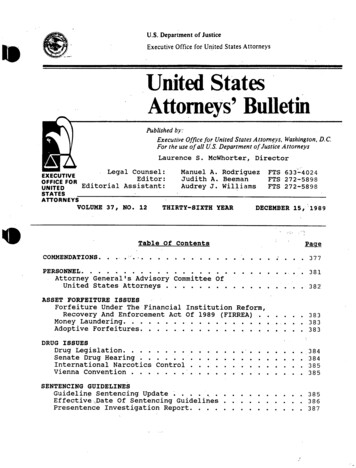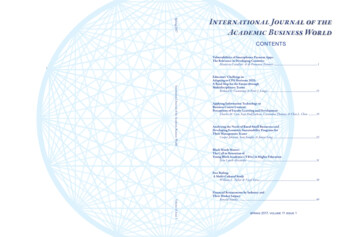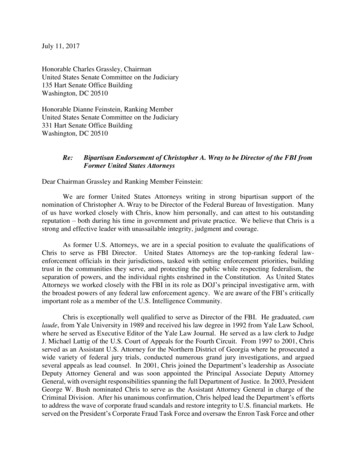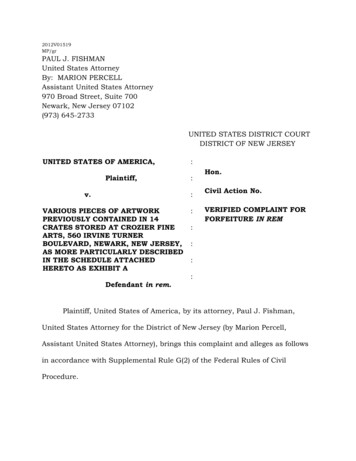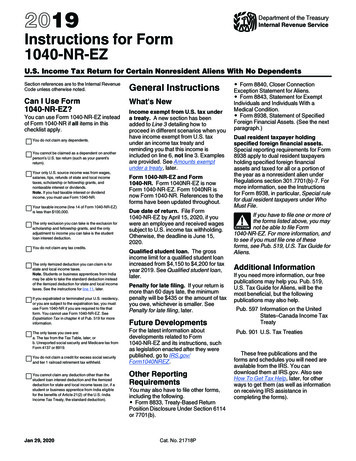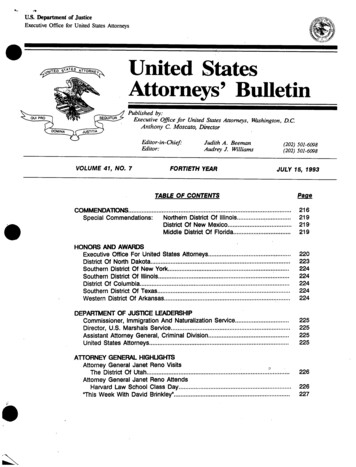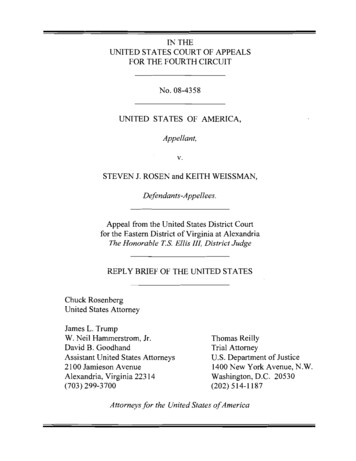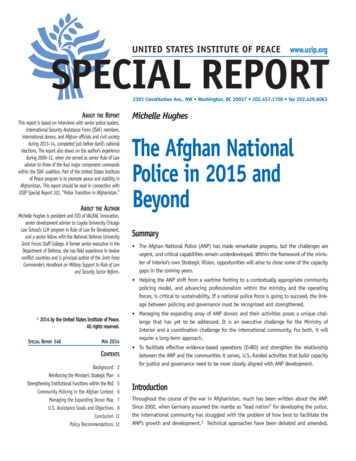
Transcription
United States Institute of Peacewww.usip.orgSPECIAL REPORT2301 Constitution Ave., NW Washington, DC 20037 202.457.1700 fax 202.429.6063About the ReportThis report is based on interviews with senior police leaders,International Security Assistance Force (ISAF) members,international donors, and Afghan officials and civil societyduring 2013–14, completed just before April’s nationalelections. The report also draws on the author’s experienceduring 2009–12, when she served as senior Rule of Lawadviser to three of the four major component commandswithin the ISAF coalition. Part of the United States Instituteof Peace program is to promote peace and stability inAfghanistan. This report should be read in connection withUSIP Special Report 322, “Police Transition in Afghanistan.”About the AuthorMichelle Hughes is president and CEO of VALRAC Innovation,senior development adviser to Loyola University ChicagoLaw School’s LLM program in Rule of Law for Development,and a senior fellow with the National Defense UniversityJoint Forces Staff College. A former senior executive in theDepartment of Defense, she has field experience in twelveconflict countries and is principal author of the Joint ForceCommander’s Handbook on Military Support to Rule of Lawand Security Sector Reform.Michelle HughesThe Afghan NationalPolice in 2015 andBeyondSummary The Afghan National Police (ANP) has made remarkable progress, but the challenges areurgent, and critical capabilities remain underdeveloped. Within the framework of the minister of interior’s own Strategic Vision, opportunities will arise to close some of the capacitygaps in the coming years. Helping the ANP shift from a wartime footing to a contextually appropriate communitypolicing model, and advancing professionalism within the ministry and the operatingforces, is critical to sustainability. If a national police force is going to succeed, the linkage between policing and governance must be recognized and strengthened. 2014 by the United States Institute of Peace.All rights reserved.Special Report 346May 2014ContentsBackground 2Reinforcing the Minister’s Strategic Plan 4Strengthening Institutional Functions within the MoI 5Community Policing in the Afghan Context 6Managing the Expanding Donor Map 7U.S. Assistance Goals and Objectives 8Conclusion 11Policy Recommendations 12 Managing the expanding array of ANP donors and their activities poses a unique chal-lenge that has yet to be addressed. It is an executive challenge for the Ministry ofInterior and a coordination challenge for the international community. For both, it willrequire a long-term approach. To facilitate effective evidence-based operations (EvBO) and strengthen the relationshipbetween the ANP and the communities it serves, U.S.-funded activities that build capacityfor justice and governance need to be more closely aligned with ANP development.IntroductionThroughout the course of the war in Afghanistan, much has been written about the ANP.Since 2002, when Germany assumed the mantle as “lead nation” for developing the police,the international community has struggled with the problem of how best to facilitate theANP’s growth and development.1 Technical approaches have been debated and amended,
About the InstituteThe United States Institute of Peace is an independent,nonpartisan institution established and funded by Congress.Its goals are to help prevent and resolve violent conflicts,promote postconflict peacebuilding, and increase conflictmanagement tools, capacity, and intellectual capitalworldwide. The Institute does this by empowering otherswith knowledge, skills, and resources, as well as by its directinvolvement in conflict zones around the globe.Board of DirectorsStephen J. Hadley, (Chair), Principal, RiceHadleyGates, LLC,Washington, DC George E. Moose (Vice Chair), Adjunct Professor of Practice, The George Washington University, Washington, DC Judy Ansley, Former Assistant to the President andDeputy National Security Advisor under George W. Bush, Washington, DC Eric Edelman, Hertog Distinguished Practitionerin Residence, Johns Hopkins School of Advanced InternationalStudies, Washington, DC Joseph Eldridge, University Chaplain and Senior Adjunct Professorial Lecturer, School of International Service, American University, Washington, DC KerryKennedy, President, Robert F. Kennedy Center for Justice andHuman Rights, Washington, DC Ikram U. Khan, President,Quality Care Consultants, LLC., Las Vegas, NV Stephen D.Krasner, Graham H. Stuart Professor of International Relationsat Stanford University, Palo Alto, CA John A. Lancaster,Former Executive Director, International Council onIndependent Living, Potsdam, NY Jeremy A. Rabkin,Professor of Law, George Mason University, Fairfax, VA J. Robinson West, Chairman, PFC Energy, Washington, DC Nancy Zirkin, Executive Vice President, LeadershipConference on Civil and Human Rights, Washington, DCMembers Ex OfficioJohn Kerry, Secretary of State Chuck Hagel, Secretary ofDefense Gregg F. Martin, Major General, U.S. Army;President, National Defense University Kristin Lord,Acting President, United States Institute of Peace (nonvoting)The views expressed in this report do not necessarilyreflect the views of the United States Institute of Peace,which does not advocate specific policy positions.To request permission to photocopy or reprint materials,e-mail: permissions@usip.orgthe “lead nation” approach gave way to more multilateral engagement, and the International Security Assistance Force (ISAF) became the de facto lead within the internationalcommunity for developing policing, even as smaller bilateral missions continued their effortsand the European Police Mission (EUPOL) pursued its own mandate.2 The United Statesemerged as the largest police donor. And through the Combined Security Transition Command – Afghanistan (CSTC-A), the U.S. arm of NATO Training Mission – Afghanistan (NTM-A),the military assumed responsibility for most police training from the traditional civilian leadfor policing assistance: the State Department Bureau of International Narcotics and LawEnforcement Affairs.3 None of these transitions happened without controversy. The military,in particular, has come under harsh criticism for its treatment of the ANP as a lightly armedelement of the Afghan National Security Forces (ANSF) rather than as a separate and distinctcivilian institution of law enforcement professionals.4This report does not replay the history or the arguments. Instead, it looks at the futureof Afghanistan once security transition is complete at the end of 2014, with an eye towardwhere U.S. assistance can have the greatest strategic impact on the future of the ANP. Thecurrent level of progress would not have happened without the U.S. military’s tremendousdrive, dedication, resources, and personal sacrifice in lives lost. At the same time, civiliancontributions, although not as well publicized, have been critical to developing core ANPcompetencies.5 If progress is strategically reinforced, the combined civil-military effort willhave laid a foundation for long-term success.BackgroundAs we look at policing in Afghanistan, we find hopeful indicators to build on. Afghan leadershave articulated a vision and are striving for self-determination and control. Human capitalwithin the Ministry of Interior (MoI) is improving, and public trust and confidence in theANP are at an all-time high.6 There is considerable momentum toward Afghan ownership ofstrengthening the ANP’s role in restoring and maintaining the rule of law. Success storiesabound (though they seldom make the news), and the progress has created opportunitiesto support Afghan initiatives and ideas that didn’t exist even a year ago. But as the securitytransition concludes at the end of 2014, the international community’s continued inabilityto pursue a coherent, comprehensive approach to security sector reform limits externalinfluence on progress and puts sustainability at risk.7Throughout the course of international engagement, security force development,which includes the police, and judicial development have been on separate paths. Theinternational community has generally acknowledged that law and order in Afghanistanwould eventually be enforced by civilian police rather than by the Afghan National Army(ANA). But almost all police development efforts, including the establishment of operational policy, force structure, and standardized training and professionalization, weremodeled on military rather than civilian police institutions. As recently as 2011, therewas no vision for what the ANP would look like once the ISAF mission was complete. TheAfghan government, however, had repeatedly refused to declare that an internal armedconflict existed, which had a direct impact on the extent to which ANSF could continue todetain insurgents and terrorists once the ISAF drawdown was complete. The internationalcoalition’s operating assumption was that the Afghan authorities would eventually makethe declaration so that the Law of Armed Conflict (LOAC) would apply to ANSF, just asit applied to ISAF forces. But the Afghans refused, leaving the ANP and elements of theNational Directorate of Security (NDS) as the only ANSF that could detain insurgents underAfghan criminal law.8 “Professionalization”—which would be required for the ANP to be2USIP.ORG SPECIAL REPORT 346
able to assume the full scope of its responsibilities for EvBO—was not discussed withouta caveat stating that it would occur only after targeted numbers of police were trainedand equipped.9 Within the security ministries, few coalition advisers even tried to discusscivilian law enforcement with their Afghan principals. That all detention operations wouldeventually have to shift to the Afghan criminal justice system was acknowledged but notallowed to influence subsequent planning.10The challenge persists. The ISAF approach remains focused on growing the number oftrained ANP to 157,000, and immediate security imperatives dominate the discussions.11With the 2014 elections seen as at risk due to insecurity, any effort to further professionalize the force is seen as a distraction. Even the ongoing effort to “train” police officers whowere assigned to the field without having completed the basic patrolman’s certificationslowed as training slots were reallocated to meet the surging demand for more women toserve as female searchers in polling places. This reallocation has left a sizable gap—morethan 8,000 untrained policemen remain on duty. While that number represents progress (ayear ago, the number was estimated at 21,000), the fact that training was held in abeyanceand viewed as nonessential in the near term is problematic. Once elections are complete,the new government will be faced with a significantly undertrained force, coinciding with areduced security assistance presence.12The overarching military train-and-equip approach has created another challenge forthe transition by failing to ensure that the ANP is appropriately institutionalized withinthe larger framework of the Afghan political system. It is notable that the ISAF’s reports toCongress, as well as other strategic assessments, make no mention of the ANP’s enduringrole as an essential component of government service.Policing is a core governance function. Or, as the Afghan Constitution states, “defending independence, national sovereignty, territorial integrity and attaining the security anddefense capability of the country shall be the fundamental duties of the state.” 13 The PoliceLaw mandates that “the police shall perform their duties under the leadership of the Ministerof Interior in the capital, and under the guidance of the governors and district chiefs in the provinces and districts respectively.”14 The minister of interior’s own “Ten-Year Vision for the AfghanNational Police” is filled with references to policing as an essential public service and to theresponsibilities of the police to the people and their lawful representatives.15 In the words ofthe governor of Ghazni Province, “When my people see the police, they are seeing the mirrorof me.” But ISAF strategies for ANP development, and the assessment frameworks used tomeasure progress, do not address the relationship of the police to the government as a metricfor operational success. The NTM-A/CSTC-A development framework remains organized aroundthe same five security-centric lines of effort that are used for the ANA.16At the same time that ISAF is scaling back, Afghan officials are becoming the greatestproponents for the professionalization of the police as a law enforcement service. Theyare talking about it, issuing policy guidance designed to further it, and making politicaldecisions based on an Afghan interpretation of Afghan law. This is not to say that theyare always sincere or that they are operating under legal norms and standards that theinternational community accepts. But they are taking ownership of their own agenda andsee the ANP as an essential component. This represents development progress and presentsnear-term opportunities that support successful security transition.Unfortunately, the international donor community and ISAF have made little progresstoward unified action that will take the ANP to the next level of professional competence.The effort continues to be ad hoc, disaggregated, and poorly defined. The absence of acontinuous, holistic strategy that can guide horizontal and vertical integration across lawenforcement actors is the most problematic characteristic of the international assistanceUSIP.ORG SPECIAL REPORT 3463
approach. It is too late now to “fix” the law enforcement assistance problem in Afghanistan.But steps can be taken that will strengthen Afghan initiatives; improve the effectiveness ofimportant, internal security related niche capabilities; and increase the chance that we mayyet have reasonably capable, reliable security partners within the ANP.Reinforcing the Minister’s Strategic PlanIn 2010, with considerable drafting assistance from the international community, the minister of interior signed a comprehensive National Police Strategy (NPS).17 The strategy wasfollowed soon thereafter by a derivative National Police Plan (NPP)—again, drafted largelyby international advisers. The NPS reflected ISAF priorities and, while the minister andhis deputies paid homage to it in all their public statements, there had been considerableNTM-A/CSTC-A effort behind the scenes to persuade the Afghans to take full ownership ofits implementation, with mixed success. It was, after all, not the minister’s plan.On October 16, 2012, shortly after General Ghulam Patang was appointed minister ofinterior, he announced a set of priorities, later codified with the help of the InternationalPolice Coordination Board (IPCB) as a “Ten-Year Vision,” during his remarks to a Provincialand District Chiefs of Police Conference that he convened in Kabul. As with a previousprofessionalization strategy that he crafted in May 2011 when he was director of the ANPTraining General Command, he did not consult with international advisers beforehand. Hedid, however, ask the then head of the IPCB for her assistance, resulting in a correspondingset of two-year implementation plans.18The minister’s Vision began with the following:Within ten years the Afghan National Police (ANP) will become a unified, capable, andtrustworthy civilian police service. Its primary responsibility will be to enforce the ruleof law; maintain public order and security; detect and fight crimes; control borders;protect the rights, assets and freedoms of both Afghans and foreigners in Afghanistanaccording to national laws; and operate without ethnic, gender, language or religiousdiscrimination. By pursuing the principles and objectives of the peace and reintegrationprogram, which is based on the decisions of the 2–4 June 2010 Consultative Jirga, andcreating a lawful society, the ANP will pave the way for sustainable peace and socioeconomic development of Afghanistan. It will be a unified and flexible force allowingpersonnel in the different police pillars of the ANP to transfer from one to the otherwhen necessary, and winning public confidence by the use of community policingapproaches to deliver policing services to the people of Afghanistan.19ANP development needs to bebased on agreed-upon goalsand objectives that reflect aministry’s institutional positionrather than the personal agendaof a particular minister.The heavy emphasis on professionalization, civilianization, and community policing wasa reflection of Minister Patang’s background as a career police officer, and it caught theinternational community off guard. As part of his implementation strategy, he proposed aseries of two-year plans, which created an immediate disconnection with the NTM-A/CSTC-Asupported NPS and NPP.20 ISAF is currently working with the MoI to develop an updated NPSand NPP, but the strategic planning framework is not yet completely reconciled.21Upon assuming control of the ministry from Patang in September 2013, the currentminister of interior, Mohammed Omer Daudzai, reaffirmed his commitment to the Vision,with the caveat that he intended to adjust priority-setting and implementation timelines asnecessary to adapt to the security situation on the ground. During discussions with provincial governors as research for this study, it was clear that they also support the goals in theVision and that it reflects their view of the ANP as essential to their own ability to govern.Ultimately, ANP development needs to be based on agreed-upon goals and objectivesthat reflect a ministry’s institutional position rather than the personal agenda of a particular minister. And development will not be sustainable unless it is aligned behind a set ofAfghan-generated two-year plans. Otherwise, consistent progress is unlikely, donor confidence and support will probably decrease, and the ISAF and other donors will continue todiffer on how the police should develop.224USIP.ORG SPECIAL REPORT 346
Development of the vision is not the only indication that the Afghans are thinking strategically. While codifying national goals and objectives, the Afghans are also affirmativelydemonstrating a growing capacity to plan and coordinate the way ahead. Election planning is a case in point. According to multiple accounts, the minister of interior, ministerof defense, and director of the NDS began planning eighteen months in advance for howthey would conduct election security, and they have been adamant that they would control the process.23 In northern Afghanistan, for example, when the German Police ProjectTeam, which had been training, mentoring, and advising the ANP since 2002, reached outto provincial leaders to offer advice and assistance, they were rebuffed because Afghanregional leaders believed they had the planning process well in hand. International advisers have had concerns about the quality of some of the security assessments the Afghanshave undertaken, but they were impressed by the progress in planning and cross-ministerialcoordination compared with the capacity before the last major elections in 2009.The MoI has demonstrated that it is furthering its own strategy and policy in other areasas well. In June 2013, in an effort to define future requirements, the minister conducted aconference to explore the question of what “community policing,” the central idea behindthe Vision, means in the Afghan context. Minister Daudzai has formulated his own needsassessment frameworks and is trying to strengthen ties with provincial governors, districtsubgovernors, and community councils at both levels in order to build recruitment in underrepresented areas and improve the relationship between the ANP and the communities itserves. Finally, although some Western donors disapprove, the ministry is reaching out toother Islamic countries in an effort to forge what it sees as culturally compatible partnerships for training and professionalization.These initiatives, and others too numerous to mention, represent serious intent, strategic thinking, and the political will to strengthen governance within the security sector. Itis important to note that the minister has gotten help from a small group of young Afghancivil servants. He has also consulted high-ranking, experienced international civilian advisers who have the pull and the executive skills to help develop an enduring capacity to manage a complex bureaucracy that sits within an equally complex political environment. Theresulting opportunities, if leveraged correctly, should inform future engagement and helpmitigate the risks involved in the handover.Strengthening Institutional Functions Within the MoIThe development of policing has focused mainly on recruiting, training, and equipping aforce of police “soldiers” who could perform basic security functions in partnership with theANA, as part of an ISAF strategy of “layered security.”24 As a result, the ministry is staffedmainly by uniformed police officers who rotate between operational and administrativeassignments and, in accordance with the minister’s Vision, between operational police pillars. This personnel turbulence within the ministry impedes continuity and the ability toadvance a complicated set of policies from design through implementation. Also, it createsa perception at odds with the concept of a democratically controlled civilian police. Whenone walks into the MoI, the overall impression is of a military organization rather than acivilian bureaucracy.Along with the problems of perception and turbulence, both the ministry and the ANPsuffer from a lack of progress in the areas of human resources and personnel administration.NTM-A/CSTC-A efforts to introduce personnel management systems, with heavy emphasison automation, have been less than successful. Basic elements, such as approved positiondescriptions, assignment policies, performance management, and merit-based qualification,are still largely nonexistent. At the end of 2013, the minister approved a bilateral proposalUSIP.ORG SPECIAL REPORT 3465
Human resources must be viewedas a mission-essential function.And program budgeting processes,and the personnel to executethem, have to become an enduringpriority; they cannot be viewed assecondary to security.for creating a Human Resource Management Unit that would have addressed the mostcritical gaps, but implementation was derailed earlier this year when the proposal did notconform to ISAF priorities.25 As a result, problems remain that are unlikely to be resolvedbefore the end of 2014.The other critical gap is in planning, programming, and budget execution. Despite pro gress in strategic planning from an operational perspective, no Afghan-led mechanisms arein place that link management of personnel, resources, and objectives. In the words of anexperienced international adviser, “The number of personnel within the Ministry of Interiorwho understand the concept of program budgeting is in double digits. A ministerial teamthat can effectively take this issue forward is nonexistent.” The challenge is exacerbated bythe number of funding streams, international advisers, and donors who are directly involvedin the allocation of ANP resources and services in kind and by a lack of capacity in theAfghan Ministry of Finance.26 NTM-A/CSTC-A is aware of the problem and has significantlyincreased the number of advisers assigned to address the issues. But the capability gapsgo beyond any one development effort and require an international response that hasn’tcoalesced. The Law and Order Trust Fund Afghanistan (LOTFA), for example, which managesinternational funds used to pay the salaries of more than 140,000 police officers, does notyet have a course of action for how it will transfer funds management to Afghan ownership.This is only one of the complex financial management functions the Afghans will have toassume, but there is no question that they are not yet ready to do so.27If the ANP is to become an accountable, public service oriented institution while also meeting the challenge of a complex and dynamic security environment, the civil servants within theministry must be capable, visible, and clearly in control of the major ministerial functions. Moreyoung civil servants like those currently adding strategic planning value need to be hired andencouraged. This requires that their career path be strengthened with the same emphasis oncareer development that is envisioned within the uniformed police. Human resources must beviewed as a mission-essential function. And program budgeting processes, and the personnelto execute them, have to become an enduring priority; they cannot be viewed as secondary tosecurity. They are essential to the sustainability of the institution and to the future of the ANP.Community Policing in the Afghan ContextThe notion of community policing for Afghanistan has often been treated as a Western ideathat is irrelevant in the current security environment. But nothing could be further fromthe truth. Without effective engagement throughout all levels of the community, the ANPlacks the ability to continuously gather information; prevent and discover crimes, includingcrimes against internal security; address causes of conflict before they escalate into fullscale factional and antigovernment grievances; and demonstrate that the government canregulate the community and keep public order. Given the ethnic and ideological fault linesthat exist across the country, and the limited reach of the central government, it is essentialthat the ANP be an adaptive and culturally sensitive organization wherever it is present.28Plans for the NATO post-2014 Resolute Support Mission anticipate that ANSF trainingand mentoring will continue throughout the coming years, albeit with significantly fewerinstructors and less direct operational involvement.29 Given this reality, it is especially critical that mission-essential tasks that are trained and advised conform to the direction thatthe ministry is trying to take. Otherwise, the ministry will be hard-pressed to establish andenforce common standards of performance across Afghanistan. In particular, Security ForceAssistance (SFA) tasks, conditions, and standards should follow those identified and certified through the ministry’s own nascent training development and certification processes.6USIP.ORG SPECIAL REPORT 346
One of the recurring challenges in the past was the fact that different U.S. battlespaceowners had their own notions of how SFA for the ANP should be conducted. As variousmilitary units deployed in and out of theater, each arrived with its own set of ideas andprocedures and little awareness of the ANP’s own operational policies, procedures, and training intent. Inconsistencies became especially obvious as combined units of ANSF attemptedto make the transition from military intelligence-led operations under LOAC, to police-ledEvBO under Afghan criminal law. Provincial prosecutors and judges complained that units didnot follow consistent procedures for evidence gathering, crime scene exploitation, arrests,and witness interviews. Efforts to standardize procedures at the national level betweenpolice and prosecutors were stymied by a lack of interministerial cooperation between theMoI and the attorney general’s office. At the subnational level, different tools, tactics, andprocedures were taught depending on the interpretation of the coalition judge advocatewho happened to be assigned to advise the SFA team assigned to a particular location atthat particular time. The net effect was that hundreds of cases were not prosecuted or werethrown out because the evidence didn’t conform to Afghan law. Aside from the problemof EvBO, inconsistencies in training standards impeded the Afghans’ ability to implementconsistent approaches and enforce common standards of performance.30Over the past two years, NTM-A/CSTC-A, the ISAF Joint Command, and the NATO SpecialOperations Component Command–Afghanistan made a concerted effort to standardize SFAthroughout the country, which resulted in greater consistency and improved effectivenessoverall. But the ISAF standards, codified in the ISAF SFA Guide, still do not represent Afghanperspectives or priorities because Afghan participation in developing the SFA Guide wasminimal.31 Nor does the SFA Guide apply to the U.S. and international civilian police advisers who are expected to operate in the country after 2014 and who are not part of a NATOmission. As a result, the SFA Guide is not an enduring solution.It is time to recognize that the Afghans must control their own standards of professionalization and performance. And if they are to do it successfully, future SFA trainers andmentors must conform to those standards, rather than the other way around. We can andshould continue to help them develop institutional guidelines and programs of instruction.But the weight of the effort should be on reinforcing the instruction that the Afghanschoose to institutionalize. Only then can they fully professionalize the force.Managing the Expanding Donor MapDuring the past twelve years, more than thirty-seven different international donors havebeen involved in supporting ANP development. Most of them are also contributing nations toNTM-A/CSTC-A, EUPOL, or both. To enable coherence, and in accordance with the AfghanistanCompact of 2006, the IPCB was established in 2007 to act as the main international bodyfor coordinating police-related international organizations, in close cooperation with theAfghans.32 The degree to which the IPCB has succeeded has varied greatly depending onseveral factors, including the strength of the leadership assigned to its implementing arm, theIPCB Secretariat. As a practical matter, with NTM-A/CSTC-A’s 2009 assumption of the lead role
Michelle Hughes The Afghan National Police in 2015 and Beyond Summary The Afghan National Police (ANP) has made remarkable progress, but the challenges are urgent, and critical capabilities remain underdeveloped. Within the framework of the minis-ter of interior's own Strategic Vision, opportunities will arise to close some of the capacity




